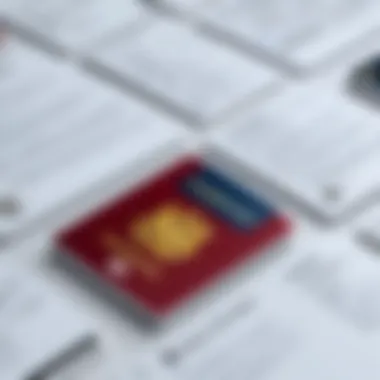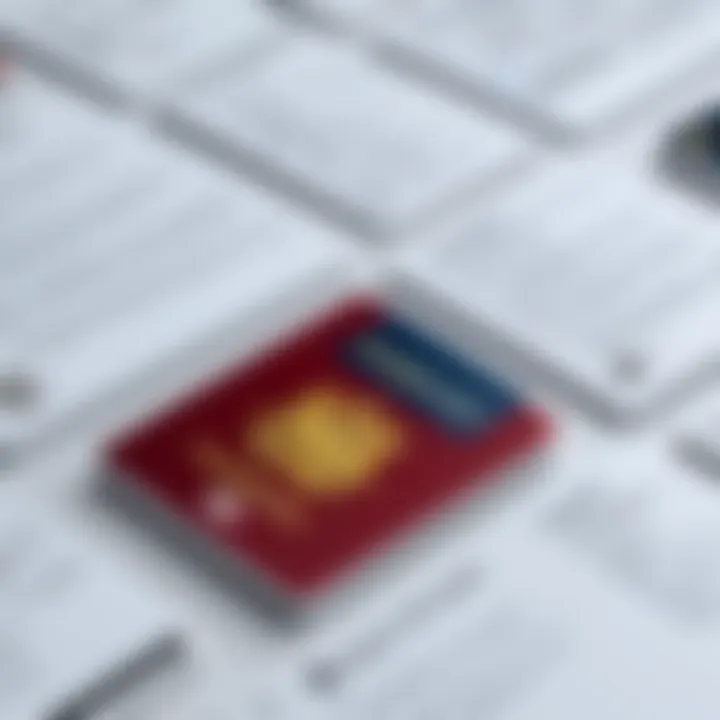Exploring Passport Alternatives: An In-Depth Guide


Intro
As the world becomes more interconnected, the need for efficient and secure travel and identification systems increases. Traditional passports, while established, do not always meet the demands of modern travelers. Innovations in technology and identification methods have prompted a reevaluation of how we verify identity, particularly when crossing borders. This article delves into the various alternatives to traditional passport systems, examining their implications for personal identification, travel logistics, and technological advancements. The objective is to provide a well-rounded insight for individuals and businesses, highlighting effective and modern solutions to meet contemporary travel demands.
Overview of Key Features
When assessing passport alternatives, it is critical to understand their core features and functionalities. These include essential software capabilities and unique attributes that set these options apart from traditional passport methods.
Essential Software Capabilities
Modern passport alternatives leverage various technological features that enhance user experience and security. Key capabilities may include:
- Biometric Integration: Use of fingerprint or facial recognition for verification.
- Blockchain Technology: Ensures data security and tamper-proof identity verification.
- Mobile Applications: Allows users to carry their identification digitally.
The integration of these capabilities can streamline travel, reduce redundancies, and improve overall safety.
Unique Features that Differentiate Options
Not all passport alternatives are created equal. Here are some unique features that might differentiate them:
- Decentralized Identity Systems: Give individuals control over their own data.
- Digital Verification: Use of QR codes or NFC technology for easy access during travel.
- Global Compatibility: Some systems can be recognized across multiple countries, enhancing their usability.
These features cater to modern travel needs, offering solutions that are streamlined and secure.
User Experience
The user experience is paramount when considering passport alternatives. This section examines the interface and usability of these solutions, as well as the support and community resources available to users.
Interface and Usability
An effective user interface is essential for any identification system. Passport alternatives should be intuitive and straightforward. Key considerations include:
- Ease of Navigation: Users should be able to access necessary features without complications.
- Mobile Compatibility: Since security is crucial, the ability to access identifications quickly can reduce stress during travel.
- Feedback Mechanisms: Options for users to report issues and get help when needed enhance overall satisfaction.
Support and Community Resources
A robust support system is vital. Users should have access to:
- Online Help Centers: Comprehensive FAQs and guides can assist users in navigating complex processes.
- Forums and Community Spaces: Platforms like Reddit can offer user-driven insights on the latest developments in passport alternatives.
- Customer Service: Friendly and responsive support personnel can make a significant difference in user experience.
Investing in modern identification methods not only enhances convenience for travelers but also responds to a growing demand for security in an increasingly digital world.
Intro to Passport Alternatives
The exploration of passport alternatives is increasingly relevant in today's world. Traditional passports, while serving a crucial function, often come with limitations and challenges that modern travelers and businesses face. The need for efficient and secure identification has given rise to innovative alternatives that challenge conventional methods.
In this article, we delve into the various alternatives to traditional passports. One major focus is on how technology plays a pivotal role in enhancing travel experiences. Passport alternatives may offer benefits such as improved security, reduced waiting times at borders, and streamlined processes for travel logistics.
The emphasis on alternative forms of identification also raises important considerations. How do these alternatives ensure data privacy? What regulatory frameworks exist to govern their use? These are crucial discussions that need to happen as society shifts toward a more digital and interconnected future.
This section will highlight key aspects of passport alternatives, emphasizing their importance in the context of a rapidly evolving travel landscape. As the demands of global mobility change, individuals and businesses alike must navigate these alternatives. Understanding their implications is essential for making informed decisions about personal identification methods and travel efficiency.
"The future of travel lies not just in passports, but in our ability to adapt and innovate with the tools at hand."
In summary, as we advance further into this guide, we will unpack these themes and provide detailed insights into the historical context, technological advancements, and the various types of passport alternatives available today. The goal is to present a comprehensive understanding of how these alternatives can potentially reshape the travel experience as we know it.
Historical Context of Passport Systems
Understanding the historical context of passport systems is vital for grasping the significance of emerging passport alternatives. The evolution of travel documentation reflects societal changes, technological advancements, and the complex nature of international relations. As global mobility has increased, so too has the necessity for secure and reliable methods of identification.
Historically, passports have served as essential tools for governments to regulate movement across borders. The concept of travel documentation can be traced back centuries. Early documents were often informal letters of permission from royalty or local authorities. Over time, the formalization of these documents evolved into the passports we recognize today.
The Evolution of Travel Documentation


The system of travel documentation saw a significant transformation post-World War I, with the establishment of standardized passport formats. This change was driven by increasing trade and travel, along with the need for security in a rapidly changing world. The introduction of photographs and personal data marked the beginning of a more regulated approach to identity verification.
In the 20th century, additional features were introduced, including machine-readable zones and biometric elements. These advancements allowed for quicker processing at borders, although they raised questions about privacy and data security. As the implementation of digital systems began, the potential for alternative forms of identification became increasingly clear.
Challenges of Traditional Passports
Despite their long history and importance, traditional passports are not without drawbacks. One of the major challenges is the lengthy processing times for issuance and renewals. In some cases, individuals face significant delays that impact their travel plans.
Moreover, traditional passports can be subject to loss or theft, leading to identity fraud. The costs associated with replacing lost documents can also be burdensome.
Another challenge lies in data security. While many passports now include biometric data, central databases can be attractive targets for cybercriminals. Several nations have reported breaches, raising concerns about how personal information is stored and protected.
"The evolution of passports from simple travel permission to complex identification tools illustrates the balance needed between security and privacy."
In summary, the historical context of passport systems shines a light on their importance in travel logistics while also highlighting the inherent challenges that call for alternative solutions. Recognizing these aspects is essential for evaluating modern identity verification methods and their potential to improve global mobility.
Technological Advances in Identification
Technological advancements have drastically changed the landscape of identification. These changes are fundamental as they pave the way for more efficient and secure methods of verifying identity, especially in the realm of travel. As the world becomes increasingly interconnected, the demand for secure and seamless travel experiences rises. Technological alternatives to traditional passports are now relevant for both individuals and businesses seeking effective identification solutions.
The intersection of technology and identification encompasses various innovations that can enhance security, improve user convenience, and decrease the time spent in identity verification processes. Additionally, technology has the power to mitigate some of the longstanding issues associated with traditional passport systems, such as loss, fraud, and bureaucratic inefficiencies.
Biometric Systems as a Solution
Biometric systems represent a key element in the modernization of identity verification. These systems rely on unique physical characteristics such as fingerprints, facial recognition, or iris scans. The strength of biometric technology lies in its capability to provide reliable and efficient authentication methods.
Several benefits highlight the advantages of biometric systems:
- Enhanced Security: Since biometric data is unique to each individual, it is difficult to forge or replicate. This provides a layer of security that traditional identification methods cannot offer.
- Speed and Efficiency: Biometric systems can process identities in mere seconds, significantly reducing wait times at borders or checkpoints.
- User Experience: Many travelers prefer a quick and straightforward method for identity verification. The convenience of using a biometric-based solution is appealing in a fast-paced travel environment.
A potential drawback remains regarding privacy and the handling of sensitive biometric data. If not well-managed, this information can lead to security risks.Striking a balance between security and privacy will be paramount for successful adoption.
Blockchain Technology in Travel
Blockchain technology also presents a transformative solution for travel-related identification processes. Known primarily for underpinning cryptocurrencies, blockchain’s decentralized ledger system can enhance identity verification across borders.
The benefits of blockchain technology in travel include:
- Immutable records: Once information is recorded on a blockchain, it cannot be altered. This adds a layer of security, helping to prevent identity fraud.
- Transparency and Trust: Transactions on the blockchain can be transparent, fostering trust between parties involved in the identification process.
- Decentralization: With no single point of failure, data can be stored across various nodes. This decentralization cuts down on the risks associated with centralized databases that can be more vulnerable to hacks.
However, challenges remain. Not all nations may accept blockchain-based solutions due to regulatory issues, leading to complications in international travel. As such, understanding these dynamics will be essential as businesses and travelers navigate the new identification landscape.
"The shift from traditional identification systems to biometrics and blockchain technology signals a new era in travel security, emphasizing the need for a more secure, efficient, and trustworthy approach to identity verification."
Types of Passport Alternatives
The landscape of travel is rapidly evolving, prompting a critical examination of types of passport alternatives. As the world becomes more interconnected, the traditional passport system can sometimes hinder efficiency. The alternatives being developed today aim to address several pressing issues related to security, identity verification, and overall travel experience.
Understanding these alternatives is vital for both travelers and organizations involved in the travel industry. This section highlights the different types of alternatives available, emphasizing their potential benefits and considerations while exploring their practical applications.
Digital Identification Solutions
Digital identification solutions represent a pivotal shift in how individuals can identify themselves for travel purposes. These solutions typically encompass various forms of electronic documentation, such as digital IDs and e-visas. The purpose of these alternatives is to facilitate a smoother travel experience by providing secure and easily verifiable identification.
One of the main attractions of digital identification is its enhanced accessibility. Travelers can access their identification via smartphones or other digital devices, minimizing the risks associated with carrying physical documents. Additionally, digital IDs can include biometric data, making it harder for individuals to impersonate someone else.
However, implementing digital identification solutions is not without challenges. Concerns over data privacy remain significant, as the storage of sensitive information on devices can be vulnerable to hacking. Moreover, the compatibility of different digital systems can lead to complications and misunderstandings at borders. Hence, it is vital for both governments and users to engage in continuous dialogue about data protection and security protocols.
Smartphone Applications for Travel
Smartphone applications have become an integral part of the travel ecosystem. These applications offer various services that go beyond simple navigation or itinerary planning. Some of these apps now serve as comprehensive travel companions that include features for identity verification and documentation management.
For instance, certain applications allow users to store digital copies of their identification documents, including passports. This digitization can be invaluable in situations where travelers misplace their physical documents. Additionally, some travel apps can integrate directly with airline and hotel systems, streamlining the check-in process and reducing the time spent at terminals.


Moreover, smartphone applications can offer real-time updates about travel restrictions or requirements, which is critical in our current global landscape marked by fluctuating regulations. However, relying on mobile applications also poses its own set of challenges, most notably the risk of losing device access due to theft or technical issues. Thus, while the advantages of travel applications are considerable, users must remain aware of potential drawbacks and have backup strategies in place.
In summary, the exploration of types of passport alternatives sheds light on innovative solutions that stand to advance the way we travel. Digital identification technologies and smartphone applications are leading the charge, promising to deliver a more secure and efficient travel experience.
Advantages of Passport Alternatives
The discussion around passport alternatives often centers on their potential benefits in comparison to traditional passports. Traditional passports, while essential, often present challenges that security and efficiency can sometimes impede. Here, we explore how passport alternatives, particularly through modern technology, bring enhanced possibilities for travelers. By delving into the important advantages, we can appreciate their role in the future of identification methods in travel.
Enhanced Security Features
One of the primary advantages of passport alternatives lies in their enhanced security features. Digital identification solutions, especially those incorporating biometric technology, provide an additional layer of protection against identity theft. With traditional passports, personal information can be more vulnerable to theft or forgery. In contrast, biometric systems leverage unique physical characteristics such as fingerprints or facial recognition.
- Reduced Fraud Risks: Biometric identifiers are difficult to replicate, significantly diminishing the likelihood of fraud. This technology is not only more secure but also provides peace of mind for travelers.
- Real-Time Verification: Alternatives like mobile identification applications enable immediate verification processes. Such immediacy can lead to tighter security for both travelers and travel establishments.
- Data Encryption: Many passport alternatives utilize sophisticated encryption technologies to safeguard personal information. This means that even if data is intercepted, it remains unreadable without the appropriate decryption keys.
"The integration of biometric technology in travel documentation represents a profound shift towards more secure travel experiences."
Streamlined Travel Processes
Another pivotal advantage of passport alternatives is their potential to streamline travel processes significantly. Traditional systems can be cumbersome and slow, leading to long wait times and frustrations.
- Quicker Check-Ins: Digital IDs allow for quicker check-in processes at airports and borders. With electronic systems, passengers can often verify their identity without needing to present a physical document, leading to speedier boarding and entry.
- Simplified Document Handling: Instead of juggling multiple pieces of identification, travelers can use a single digital solution. This not only reduces the chances of losing important documents but also simplifies the travel experience overall.
- Efficiency in Cross-Border Travel: As more countries adopt digital frameworks, the ease of crossing borders increases. Travelers can experience smoother transitions between countries, which is particularly beneficial for frequent flyers.
Passport alternatives, when properly implemented, are not only about making the world of travel more efficient. They also address critical security concerns that have become prominent in today’s landscape. As we continue to explore these alternatives, it becomes evident that they offer a promising path forward for the future of travel documentation.
Potential Drawbacks of Passport Alternatives
While the discussion around passport alternatives often leans towards their potential benefits and innovations, it is equally important to examine the inherent drawbacks. Understanding these challenges allows stakeholders to navigate potential pitfalls effectively. In evaluating the adoption of passport alternatives, two significant areas demand careful consideration: data privacy concerns and regulatory challenges.
Data Privacy Concerns
Data privacy stands out as a pressing issue in the realm of passport alternatives. With the shift towards digital solutions, vast amounts of personal data are at risk of exposure. Unlike traditional passports, which are physical documents, digital identities often require a network of servers and cloud storage for management. This reliance on technology increases the vulnerability to data breaches.
When exploring digital identification solutions, it is essential to consider the following points related to data privacy:
- Storage and Security: How and where personal data is stored can pose risks. If not adequately protected, sensitive information might fall into the wrong hands.
- Consent and Control: Users may lack clarity regarding how their data is being used or shared. This raises ethical concerns about consent and personal agency over one’s own information.
- Legal Framework: The absence of a robust legal framework governing data privacy can lead to unregulated use of personal data, creating further risks for individuals.
"Data privacy is not just a technological issue but a significant social concern that affects public trust in new systems."
As countries and companies push forward with passport alternatives, these privacy concerns must be prioritized to ensure user trust and widespread adoption.
Regulatory Challenges
The implementation of passport alternatives is also fraught with regulatory hurdles. Different countries have varying legal standards for identification and data management, which complicates the integration of new systems across borders. Here are some fundamental regulatory challenges:
- Diverse Standards: Countries may adopt different standards for biometric data, leading to inconsistencies and complications in international travel. These differing standards can inhibit the widespread adoption of a unified travel solution.
- Compliance Requirements: Organizations developing or managing passport alternatives must ensure compliance with numerous regulations, which can differ significantly from one jurisdiction to another. This complexity may slow down innovation or create barriers for new entrants.
- Global Cooperation: Effective use of passport alternatives requires collaboration among nations. However, political considerations can hinder this cooperation, making it difficult to establish cohesive policies and frameworks.
Mitigating these challenges requires proactive engagement from stakeholders, including governments, technology companies, and civil society.
Understanding the potential drawbacks of passport alternatives is crucial for anyone considering their implementation. By addressing issues related to data privacy and regulatory compliance, it is possible to create a more secure and user-friendly identification system.
Case Studies of Implemented Alternatives
The exploration of passport alternatives gains depth through real-world case studies. These examples illustrate the practical implementation of new identification methods, showcasing both successes and challenges. Understanding these case studies can offer valuable insights into how different regions are adapting to modern demands for travel.
Countries Innovating with Digital IDs
Numerous countries are at the forefront of introducing digital identification systems, transforming traditional methods of verifying identity. Estonia is a prime example, having established an advanced e-identity program that allows citizens to access a wide range of services online. By leveraging digital IDs, Estonian residents can make transactions securely without a physical passport. This initiative not only enhances efficiency but also promotes security in digital interactions.
Another notable country is India, which launched the Aadhaar system. This unique identification number assigns biometric data to residents, enabling streamlined verification processes. The Aadhaar system has revolutionized service access for millions, highlighting the potential for digital IDs to replace physical travel documents in various contexts.
In Sweden, the BankID initiative offers another perspective. It is widely accepted across various sectors, from banking to healthcare. The success of these digital ID systems suggests a significant shift toward trust in technology for identity verification, an important consideration for the future of travel.
Successful Adoption of Biometric Systems


Biometric systems have seen successful adoption in several countries, enhancing security and streamlining travel. For instance, the implementation of fingerprint and facial recognition technology at airports like Singapore's Changi Airport illustrates this trend. Passengers can check in and board flights using biometric verification, significantly reducing wait times and improving overall travel experience.
The United States has integrated biometric systems in its Global Entry program. This program allows pre-approved travelers to use kiosks that scan their fingerprints and facial images for quicker entry into the country. Such integrations highlight the potential to minimize manual checks while enhancing security protocols.
Additionally, the United Arab Emirates is leading in biometric innovations, implementing systems that allow residents to use their facial recognition for various services, including airport immigration. This approach not only improves efficiency but also acts as a deterrent against identity fraud.
These case studies reveal the transformative potential of both digital IDs and biometric systems. As countries innovate, they provide a blueprint for the future of travel identity verification.
In summary, the evidence from these case studies provides a rich understanding of how passport alternatives are being embraced globally. They showcase the benefits of modernization, though challenges regarding privacy and implementation must be considered. The shift towards digital solutions and biometric systems represents a crucial evolution in travel and identity verification.
Impact on Identity Verification
Identity verification is a vital component of modern travel and security systems. As traditional passports face challenges, the implementation of passport alternatives is influencing identity verification profoundly. These alternatives are shaping how individuals validate their identities during travels and transactions, giving rise to questions about accuracy, speed, and security. The integration of these alternatives can significantly streamline verification processes, leading to more efficient travel experiences.
Shifting Paradigms in Identity Assessment
The traditional paradigm of identity assessment typically relies on physical documents, which can easily be forged or misplaced. With the advent of digital identification solutions, the requirements are changing. Digital IDs, biometrics, and mobile applications are being adopted more widely, offering reliable alternatives to physical documents.
These technologies bring several benefits:
- Greater accuracy: Biometric systems, for example, match unique physical characteristics, making identification far more precise.
- Enhanced speed: Digital solutions can verify identities in seconds compared to the minutes or longer often required for traditional checks.
- Improved accessibility: As more individuals gain access to smartphones, digital IDs can be stored and easily retrieved, eliminating the need for carrying multiple physical copies.
- Secure data management: Blockchain technology can provide tamper-proof identification records, adding another layer of security.
However, adopting such alternatives also introduces complications. Some users may face challenges with technology, such as incompatibility with devices or lack of online access. To navigate these issues effectively, an ongoing dialogue between tech developers, regulatory bodies, and users is crucial to refining these systems.
Integration with Other Security Measures
The incorporation of passport alternatives into broader security measures stands as a significant consideration in the evolution of identity verification. When combined with existing security frameworks, these alternatives offer a more robust approach to safeguarding identities.
For instance, a multi-layered security system can be established through:
- Layering biometric scanning with ID verification: This approach doubles the assurance that an individual is who they claim to be.
- Utilizing artificial intelligence: AI can analyze patterns and behaviors during transactions, flagging anomalies that require further scrutiny.
- Real-time monitoring: Systems may check against databases instantaneously, revealing if the identity has been flagged for any reason.
Future of Passport Alternatives
As globalization increases, the landscape of travel continues to evolve. Hence, the future of passport alternatives emerges as a significant subject in discussions around identification and security. New approaches to travel documentation not only reflect contemporary needs but also signify a shift towards a more integrated and technology-driven system. Passport alternatives, such as digital IDs and biometric solutions, promise streamlined processes, enhanced security, and adaptability to diverse international regulations.
The importance of passport alternatives stems from several key elements. They address the inefficiencies associated with traditional passports. The lengthy verification procedures, risk of loss or theft, and the potential for forgeries give rise to the need for more reliable systems. Furthermore, as travel restrictions become more complex, passport alternatives provide solutions that can be updated more easily compared with traditional documentation. Using comprehensive digital tools, travelers can manage their information more effectively.
The consideration of how closely passport alternatives align with global standards also plays a crucial role in their future development. Harmonization among countries can lead to greater acceptance of these alternatives. It paves the way for international agreements that standardize requirements for identity verification. Thus, while innovation is essential, collaboration among nations is vital for widespread adoption of these new systems.
Predictions for Global Standards
Looking ahead, the establishment of global standards for passport alternatives appears likely. Several countries are exploring frameworks that could lead to a unified approach. This standardization could help ease international travel by reducing the discrepancies between systems. Regulatory bodies and travel organizations may advocate for models that protect travelers’ data while ensuring effective identification.
The integration of biometric data into alternative systems is another promising direction. As governments adopt stricter security measures, biometric identification is expected to become commonplace in many countries. Governments and technology providers must work together to create protocols that allow data to be shared and understood globally, minimizing the risk of fraud without invading individual privacy.
Emerging Trends in Travel Technology
New trends in travel technology significantly shape the future of passport alternatives. For instance, artificial intelligence is poised to play a vital role in verifying identities and analyzing travel patterns. The rise of mobile applications that not only store digital identification but also facilitate check-ins and security processes points towards enhanced convenience.
Additionally, the popularity of contactless technology cannot be overlooked. Integration with mobile devices for identification purposes simplifies the travel experience. Touchless interactions, especially in post-pandemic society, become a necessity rather than an option.
As such alternatives continue to evolve, collaboration and compliance become the pillars of ensuring that security, privacy, and usability are maintained.
The End: Evaluating Passport Alternatives
In the realm of travel and identification, the evaluation of passport alternatives stands as a pivotal task, addressing emerging trends and technological advancements. The comprehensive approach taken throughout this article reveals that these alternatives are not simply a replacement for traditional passports; they represent a paradigm shift in how we perceive identity and security in travel.
Effective evaluation must consider several key elements, including security, efficiency, user experience, and regulatory compliance. Each alternative, whether biometric systems, digital identification solutions, or smartphone applications, brings specific advantages that can enhance security features. These innovations often streamline travel processes, reducing wait times and enhancing the overall traveler experience.
Conversely, the potential drawbacks cannot be overlooked. Concerns regarding data privacy, the necessity for robust regulatory frameworks, and the reliability of technology must be part of any thorough assessment. This discussion must also embrace how international standards are evolving in response to these alternatives.
"In a world that is increasingly interconnected, our methods of identification must keep pace with the expectations and realities of modern travel."
The implications of evaluating these passport alternatives extend beyond mere convenience. They pose a fundamental challenge to traditional systems and force a reconsideration of how we enforce identity verification globally. The future landscape of travel identification may well be defined by how effectively stakeholders can integrate these alternatives into existing frameworks.







